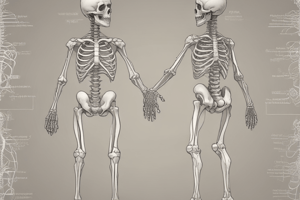Podcast
Questions and Answers
Which type of tissue helps to raise hairs in the skin?
Which type of tissue helps to raise hairs in the skin?
- Muscle (correct)
- Nervous
- Epithelium
- Connective
What is the function of the lymphatic system?
What is the function of the lymphatic system?
- To regulate body temperature
- To pump blood throughout the body
- To return fluid in the tissues to the circulation (correct)
- To digest food
What is the main function of the respiratory system?
What is the main function of the respiratory system?
- To inhale oxygen and exhale carbon dioxide (correct)
- To regulate body temperature
- To pump blood throughout the body
- To digest food
What type of tissue lines the vessels and lymph nodes in the lymphatic system?
What type of tissue lines the vessels and lymph nodes in the lymphatic system?
What is the main function of the digestive system?
What is the main function of the digestive system?
What type of tissue makes up the brain and spinal cord?
What type of tissue makes up the brain and spinal cord?
What is the main function of the endocrine system?
What is the main function of the endocrine system?
What is the main function of the cardiovascular system?
What is the main function of the cardiovascular system?
What type of tissue lines the tubes in the urinary system?
What type of tissue lines the tubes in the urinary system?
What type of tissue helps to regulate body temperature in the respiratory system?
What type of tissue helps to regulate body temperature in the respiratory system?
Study Notes
Levels of Organisation
- The body can be broken down into levels: atomic, molecular, cellular, tissue, organ, organ system, and organism
- Each level builds upon the previous one to form a hierarchical structure
Cells
- Cells are the building blocks of all living things
- Cells are specialized for particular functions, such as taking up nutrients, creating energy, and providing structure
- The function of the cell determines its shape and structure, and which organelles are predominant
Cell Structure
- Cells are made up of:
- Cell (plasma) membrane: semipermeable membrane that allows some molecules to pass through
- Nucleus: "control center" of the cell that contains genetic material (DNA)
- Cytoplasm: substance of the cell that contains organelles
- The nucleus has three regions:
- Nuclear membrane: similar to the plasma membrane
- Nucleolus: site of ribosome production
- Chromatin: composed of DNA and protein, condenses to form chromosomes during cell division
Cytoplasmic Organelles
- Mitochondria: "powerhouse" of the cell, produces energy for the cell through cellular respiration
- Ribosomes: sites of protein synthesis, found free in the cytoplasm or attached to the rough endoplasmic reticulum
- Endoplasmic Reticulum (ER): series of folded membranes, has two types: rough ER (studded with ribosomes) and smooth ER (manufactures lipids, phospholipids, and hormones)
- Golgi Apparatus: receives proteins from the ER, modifies and packages them in vesicles, and sends them to where they are needed
- Lysosomes: type of vesicle that contains digestive enzymes that break down materials within the cell
- Cytoplasmic Inclusions: vesicles, vacuoles, and lipid droplets in the cytoplasm that function in storage and transport
Tissues
- There are four main types of tissues: epithelial, connective, muscle, and nervous
- Each tissue type has specific functions and characteristics
Organ Systems
- Skeletal and Muscular Systems: provide form and support to the body, enable movement
- Lymphatic System: returns fluid in the tissues to the circulation, complementary to the circulation
- Respiratory System: involved in gas exchange, includes upper respiratory tract, lungs, muscles, and is protected by ribs
- Digestive System: breaks down food into small particles to be absorbed and used by the body
- Nervous System: controls, regulates, and communicates with different systems in the body
- Endocrine System: regulates growth, reproduction, energy, stress, metabolism, etc. through hormones
- Cardiovascular System: transports nutrients and oxygen to body tissues and removes waste products
- Urinary System: eliminates waste products and clears toxins from the blood, maintains water homeostasis and electrolyte concentrations
- Reproductive System: produces sex hormones, involved in sexual reproduction
Studying That Suits You
Use AI to generate personalized quizzes and flashcards to suit your learning preferences.
Related Documents
Description
Learn about the levels of organisation of organ systems, types of tissues, and the structure and function of cells and their organelles in vertebrates.




